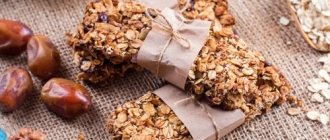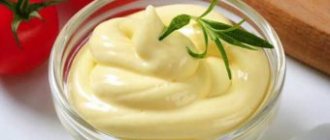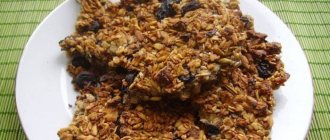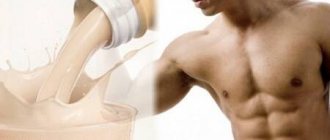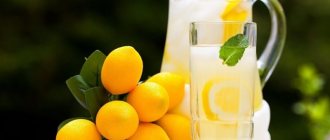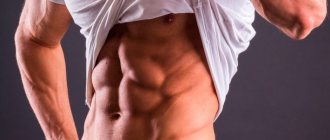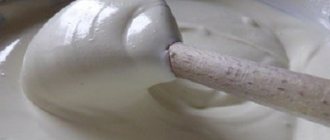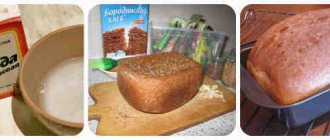Sea bass: description, calorie content, nutritional supplements, benefits and harm
01/11/2015 / Fish and seafood
| Hot smoked sea bass, BZHU and calorie content per 100 g of product | |||
| Calorie content 175 kcal | Proteins 23.5 g | Fat 9 g | Carbohydrates 0 g |
Sea bass belongs to the genus of bony fish in the scorpionfish family. All percoid fish are distinguished by the presence of sharp fin rays on the upper back. If you prick yourself with a perch's fin, you risk getting inflammation at the injection site, since it has poisonous glands.
Sea bass often ends up in stores in the form of fresh frozen and separated carcasses. They are easy to clean, which adds to their attractiveness. Sea bass is especially tasty if smoked.
The benefits and harms of sea bass
Eating and cooking perch is associated with certain risks, in particular, the high selenium content, if consumed in excess, can lead to deterioration in the health of hair, skin, and other undesirable consequences.
The meat of this fish (per 100 g) contains many vitamins, such as:
- A – 15 mcg (1.7% of the daily value), with vitamin deficiency, night blindness and dry eyes develop.
- B1 – 0.04 mg (3.8%), vitamin deficiency threatens brain damage.
- B4 – 78.6 mg (15.7%), vitamin deficiency threatens gastritis, increased blood pressure, and arrhythmia may also occur.
- B12 – 1.7 mcg (71.7%), vitamin deficiency threatens increased fatigue and memory impairment.
- D – 1.4 mcg (9.3%), with a deficiency, rickets and destruction of bone tissue develop.
- D3 – 1.4 mcg (8.6%), with vitamin deficiency, rickets and osteoporosis develop, and the risk of cancer and cardiovascular diseases increases.
- E – 0.9 mg (6.2%), vitamin deficiency threatens diseases of the nervous and muscular systems and anemia.
- RR – 1.2 mg (7.6%), with vitamin deficiency, pellagra develops (disorder of the digestive system and skin lesions).
Sea bass (the benefits and harms of introducing this fish into the diet are determined by its composition) contains taurine. This is a special acid that contains sulfur and stimulates brain activity. Its deficiency negatively affects the state of vision and the nervous system.
On the other hand, as a result of increasing levels of mercury pollution in the ocean, dishes made from this fish should be consumed with caution. In addition, the species “sea perch” belongs to the “scorpion fish” family, therefore, sharp spines connected to poisonous glands are hidden in their fins. An injection from such a thorn when processing fish in the kitchen can cause inflammation or an allergic reaction.
Compound
Smoked perch contains:
- many useful elements: magnesium, iodine, phosphorus, sulfur, chromium, sodium, calcium, chlorine, potassium, iron, copper, zinc, manganese, molybdenum, nickel, fluorine;
- most vitamins PP, C, A, D, E, B;
- polyunsaturated fatty acids;
- essential protein and taurine.
Despite being rich in valuable elements, perch meat has a fairly low calorie content. 100 g of smoked perch contains 123 kcal. Calorie content of boiled perch is 112 kcal. Fried perch is the highest in calories - 187 kcal.
How to reduce calories?
Raw sea bass contains 79 kcal per 100 g. Cold smoked sea bass has a calorie content of 88 kcal. If you boil 100 g of sea bass, its energy value will be 112 kcal, and if you fry it - 137.
Sea perch, the benefits and harms of which depend on the method of preparation, undergoes minimal heat treatment when smoked. Processing products with smoke is harmful because they carry the risk of infections and parasitic diseases, for example, opisthorchiasis. In addition, benzopyrene, a carcinogenic substance, accumulates in products.
Smoked products also contain a lot of table salt, the use of which disrupts the mineral balance of the body, leaching calcium, magnesium and potassium. On the other hand, as a result of cold smoking, a larger percentage of useful substances remains in the fish - essential amino acids, vitamins - B12, B6, E, D, A; fish oil, minerals.
The most harmless way to reduce the calorie content of sea bass is steaming - per 100 g of product the calorie content is 104 kcal, while minimizing the likelihood of the harmful effects of infections, carcinogens and excessive consumption of table salt.
The most effective and harmless way to reduce the calorie content of perch is to prepare a complex dish from it, for example, celery soup with sea bass meat. The calorie content of such a dish per 100 g will be 44 kcal.
Storage conditions
Hot smoked sea bass can be stored for several days in the refrigerator. You can increase the shelf life to two weeks if you use vacuum packaging. If such packaging is not available, the finished smoked products must be wrapped in paper so that other products do not absorb the smell of smoke.
Sea bass is a real delicacy that is not only tasty, but also healthy for the human body. Regular consumption of the dish will solve many health problems. At the same time, the delicacy prepared at home is much healthier and tastier than purchased products, because it does not contain any harmful additives or preservatives. The main thing is to buy fresh raw materials to get a truly tasty delicacy.
Calorie content Hot smoked perch. Chemical composition and nutritional value.
Hot smoked perch is rich in vitamins and minerals such as: vitamin PP - 28.5%, potassium - 13%, calcium - 15%, magnesium - 16.5%, phosphorus - 26.9%, chlorine - 51.9%, iodine - 40%, cobalt - 300%, copper - 12%
- Vitamin PP is involved in redox reactions of energy metabolism. Insufficient vitamin intake is accompanied by disruption of the normal condition of the skin, gastrointestinal tract and nervous system.
- Potassium is the main intracellular ion that takes part in the regulation of water, acid and electrolyte balance, and is involved in the processes of conducting nerve impulses and regulating blood pressure.
- Calcium is the main component of our bones, acts as a regulator of the nervous system, and is involved in muscle contraction. Calcium deficiency leads to demineralization of the spine, pelvic bones and lower extremities, increasing the risk of developing osteoporosis.
- Magnesium is involved in energy metabolism, the synthesis of proteins, nucleic acids, has a stabilizing effect on membranes, and is necessary to maintain the homeostasis of calcium, potassium and sodium. A lack of magnesium leads to hypomagnesemia, an increased risk of developing hypertension and heart disease.
- Phosphorus takes part in many physiological processes, including energy metabolism, regulates acid-base balance, is part of phospholipids, nucleotides and nucleic acids, and is necessary for the mineralization of bones and teeth. Deficiency leads to anorexia, anemia, and rickets.
- Chlorine is necessary for the formation and secretion of hydrochloric acid in the body.
- Iodine is involved in the functioning of the thyroid gland, ensuring the formation of hormones (thyroxine and triiodothyronine). Necessary for the growth and differentiation of cells of all tissues of the human body, mitochondrial respiration, regulation of transmembrane transport of sodium and hormones. Insufficient intake leads to endemic goiter with hypothyroidism and slowing of metabolism, arterial hypotension, stunted growth and mental development in children.
- Cobalt is part of vitamin B12. Activates enzymes of fatty acid metabolism and folic acid metabolism.
- Copper is part of enzymes that have redox activity and are involved in the metabolism of iron, stimulates the absorption of proteins and carbohydrates. Participates in the processes of providing oxygen to the tissues of the human body. Deficiency is manifested by disturbances in the formation of the cardiovascular system and skeleton, and the development of connective tissue dysplasia.
You can see a complete guide to the healthiest foods in the “My Healthy Diet” app.
Energy value, or calorie content, is the amount of energy released in the human body from food during the digestion process. The energy value of the product is measured in kilocalories (kcal) or kilojoules (kJ) per 100 grams. product. The kilocalorie used to measure the energy value of food is also called a food calorie, so when caloric content is reported in (kilo)calories, the prefix kilo is often omitted. You can see detailed energy value tables for Russian products here.
Benefit
- Smoked perch meat is a source of protein and amino acids necessary for the human body.
- A large amount of iodine is beneficial for the functioning of the thyroid gland.
- Selenium works to improve immunity.
- Phosphorus promotes bone integrity and stone breakdown.
- Protein helps rapid tissue repair.
- Omega 3 (fatty acid) can balance the cardiovascular system and lower cholesterol levels.
- The amino acids and vitamins contained in it contribute to the proper functioning of the reproductive and nervous systems.
Composition, calorie content and beneficial properties
River perch contains vitamins and a full range of minerals, including rare ones such as phosphorus. The benefits of fish for the body are high:
- supplies protein that is easily digestible;
- improves the functioning of the central nervous system and brain;
- restores vision;
- strengthens blood vessels and heart;
- has a positive effect on metabolism.
Meat strengthens the immune system and contains a minimum of excess calories.
| Calorie content and nutritional value of smoked perch | ||
| Parameter | H/c | H/c |
| Calories | 117 kcal | 88 kcal |
| Squirrels | 24.9 g | 26 g |
| Fats | 1.2 g | 1 g |
| Carbohydrates | 0 g | 0 g |
Application
When hot smoked, perch does not fall apart, which makes it suitable for this type of cooking. The gutted fish is rubbed with a marinade of olive oil with lemon juice and spices, then the meat is kept in a cool, dark place for an hour. After this time, alder or apple wood shavings are poured into the smokehouse. The fish is placed on a special grill and placed on the coals. Sea bass smokes quickly - about half an hour, and thanks to its rich taste, it does not particularly need sauces or seasonings.
Market Analytics
- Global cosmetics market 2021: an unprecedented test for the global cosmetics industry
- Top 10 Cosmetic Research and Development of 2021
- 2020 in the beauty industry - innovation without borders
Convenient search for beauty salons on our website
Beauty salons in Moscow Beauty salons in St. Petersburg Beauty salons in Ekaterinburg Beauty salons in Novosibirsk
Latest blog posts on our website
- Naturecream / Esterified oils
- Naturecream / Arnica - the magical plant of alchemists
- Naturecream / Tremella Extract - Snow Mushroom Detox for Skin
- Prostye-sovety / How to visually enlarge your lips with makeup
- Naturecream / Apricot kernel oil for face
- Naturecream / MATRIXYL3000 - the best skin elasticity stimulator
- Naturecream / SPF in Natural Oils
- Naturecream / Geranium (Pelargonium) oil for skin health and beauty
- Prostye-sovety / Save on a beauty salon: procedures that can be done at home
- Naturecream / Growth Factor - brings back youth?
Latest forum topics on our website
- Natalya / How to properly make a gelatin mask?
- Mrs._Smith / Badly sunburned! What to do?((
- Ice / Is it necessary to combine fitness classes with a diet?
- Antonova / What can be used for hair loss?
- Radio operatorKat / Who was on a protein diet?
Other articles in this section
| Sea urchin In Sardinia, it is customary to catch sea urchins from the beginning of December to the beginning of May. This is the official time for sea urchin fishing on the island. This sea animal is the most favorite delicacy among people living in Sardinia. Not many people in Russia even know anything about sea urchins. All knowledge is limited only to the fact that you cannot step on them, as they have poisonous needles. Of course, for tourists, rubber slippers will be an excellent protection against these marine inhabitants. But not everyone here had the opportunity to taste the sea urchin. |
| Atlantic sardine with added oil Sardine is a marine fish that lives mainly in the Atlantic Ocean and the Mediterranean Sea. Belongs to the herring family, small in size - depending on the species, it can be from 15 to 25 centimeters. Fish gather in schools, the length of which can reach several kilometers, and move in search of food. The scales of a live sardine shimmer in different colors - silver, blue, green. |
| Nelma Nelma is a whitefish, belongs to the whitefish class, the salmon family. Nelma is a freshwater fish, semi-anadromous. Its habitat is the Arctic Ocean basin, the Manesi and Ponoi rivers. It is one of the largest representatives of its genus (weight can reach 50 kg, and dimensions up to 1.5 meters in length). |
| Dried squid For residents of Asian countries, squid are an integral part of the daily diet. It is known that Asians eat squid in almost any form. Marinated, raw, stuffed, boiled or fried squid are especially popular. |
| Fresh carp In ancient times, when the Celestial Empire was the basis of human culture, a new species of fish was developed, which was named carp. The Chinese carried out the “cultivation” of wild carp, and the results were simply amazing. The new species reproduced well and gained weight extremely quickly. |
| Granular sturgeon caviar Black sturgeon caviar is an expensive and rare delicacy. It so happened that all over the world it is associated precisely with Russia, in whose cuisine it is often found in various dishes, as well as with Iran, where it is found raw. The place where sturgeon caviar is mined is the Caspian Sea, where up to 90% of the world's production falls. |
| Lightly salted trout Trout is a fish that belongs to the salmon family. A characteristic feature of the species is its spotted coloration. It lives in bodies of water in the northern hemisphere of the Earth. Trout is called a fish of crystal clear water, since the slightest contamination of the habitat with chemical elements or toxins leads to the death of the species. In the clean, transparent water of mountain rivers and lakes, trout grows up to 90 cm and weighs about 25 kg. On average, the carcass is 30-40 cm long and weighs 600-700 g. |
| Stewed cod This type of fish belongs to the cod family and lives in large numbers in the cold waters of the Atlantic Ocean. The body of cod is somewhat elongated and has a greenish or brown tint. The fish can reach two meters in length. For industrial purposes, meter-sized cod and smaller ones are used more. The fish is quite popular among consumers, so its fishing is carried out on a large scale. Depending on their habitat, cod has several subspecies. They distinguish these individuals, in most cases, solely by appearance and size. |
| Boiled catfish This type of fish belongs to the catfish-like order and is a large freshwater fish. The catfish reaches five meters in length. There are individuals that weigh half a ton. While hunting at night, during the day the catfish rests in deep holes or under snags. |
| Anglerfish The anglerfish lives in the World Ocean. This fish tends to live very deep underwater - the anglerfish most often dives to a depth of 3 km. |
How to cook smoked perch
Smoked perch meat is tender, aromatic, white, lean, and has excellent taste. To prepare it, you can use several recipes:
1 way. Hot smoking is considered the most common. To achieve a special aroma, the following trees are used as fireboxes:
- beech;
- oak;
- hornbeam;
- poplar;
- alder;
- fruit trees.
Hot smoking time is about two hours. It is not recommended to add spices.
On a note! After removing the smoking chamber from the heat, do not open the lid until it has cooled completely.
Method 2. With “semi-hot” smoking, perch is smoked at a smoke temperature of +50 °C, removing the lid from the smoking chamber. The time of such smoking is 10 hours.
Preparing fish for smoking
Before you start hot smoking, you need to properly prepare the fish for processing. Initially, the carcasses should completely melt if frozen products were purchased. To avoid the cutting process, you can purchase ready-made fillets right away.
Fish cutting
If you purchased a whole perch, you must first carefully remove the insides and cut off the head. Next, the carcasses are thoroughly washed under cold running water. There is no need to remove the scales. Cleaned carcasses are thoroughly wiped with napkins to remove excess moisture. After this, you can begin the process of marinating or salting.
Salting or marinating
Hot smoked sea bass can either be simply salted or marinated. In the first case, it is enough to thoroughly rub each carcass with salt, both outside and inside. Then the fish is placed in a container. Each layer is additionally sprinkled with salt. The carcasses are sent to marinate in the refrigerator for 10-12 hours.
If using marinade, it must be prepared in advance. Salt and sugar, favorite spices and spices are added to the water. Everything is thoroughly mixed and brought to a boil. When the marinade has cooled completely, pour it over the prepared carcasses and leave them to marinate in the refrigerator for 6-8 hours.
After the fish is marinated well enough, it must be rinsed under running water and dried a little to remove unnecessary moisture.
Only after this can you begin the smoking process.
Calorie content Hot smoked perch. Chemical composition and nutritional value.
Nutritional value and chemical composition of “Hot smoked perch”.
The table shows the nutritional content (calories, proteins, fats, carbohydrates, vitamins and minerals) per 100 grams of edible portion.
| Nutrient | Quantity | Norm** | % of the norm in 100 g | % of the norm in 100 kcal | 100% normal |
| Calorie content | 175 kcal | 1684 kcal | 10.4% | 5.9% | 962 g |
| Squirrels | 23.5 g | 76 g | 30.9% | 17.7% | 323 g |
| Fats | 9 g | 56 g | 16.1% | 9.2% | 622 g |
| Water | 53.5 g | 2273 g | 2.4% | 1.4% | 4249 g |
| Ash | 9.7 g | ~ | |||
| Vitamins | |||||
| Vitamin A, RE | 20 mcg | 900 mcg | 2.2% | 1.3% | 4500 g |
| Vitamin B1, thiamine | 0.05 mg | 1.5 mg | 3.3% | 1.9% | 3000 g |
| Vitamin B2, riboflavin | 0.12 mg | 1.8 mg | 6.7% | 3.8% | 1500 g |
| Vitamin E, alpha tocopherol, TE | 1 mg | 15 mg | 6.7% | 3.8% | 1500 g |
| Vitamin RR, NE | 5.7 mg | 20 mg | 28.5% | 16.3% | 351 g |
| Macronutrients | |||||
| Potassium, K | 193 mg | 2500 mg | 7.7% | 4.4% | 1295 g |
| Calcium, Ca | 64 mg | 1000 mg | 6.4% | 3.7% | 1563 g |
| Magnesium, Mg | 26 mg | 400 mg | 6.5% | 3.7% | 1538 g |
| Sodium, Na | 3174 mg | 1300 mg | 244.2% | 139.5% | 41 g |
| Sera, S | 175 mg | 1000 mg | 17.5% | 10% | 571 g |
| Phosphorus, P | 211 mg | 800 mg | 26.4% | 15.1% | 379 g |
| Chlorine, Cl | 4895 mg | 2300 mg | 212.8% | 121.6% | 47 g |
| Microelements | |||||
| Iron, Fe | 1.2 mg | 18 mg | 6.7% | 3.8% | 1500 g |
| Yod, I | 60 mcg | 150 mcg | 40% | 22.9% | 250 g |
| Cobalt, Co | 30 mcg | 10 mcg | 300% | 171.4% | 33 g |
| Manganese, Mn | 0.1 mg | 2 mg | 5% | 2.9% | 2000 g |
| Copper, Cu | 120 mcg | 1000 mcg | 12% | 6.9% | 833 g |
The energy value of hot smoked perch is 175 kcal.
Is it possible for pregnant, lactating, children
Smoked fish is an undesirable product during pregnancy. Causes:
- there is a risk of helminth infection;
- the product is saturated with salt, therefore it contributes to the formation of edema and late toxicosis;
- food poisoning from eating low-quality fish, which can cause miscarriage or premature birth;
- carcinogens slow down the development of the fetus and cause the formation of congenital pathologies in the child.
You should also avoid using it during breastfeeding. A salty product impairs lactation, and carcinogens can cause food allergies in the baby.
Introduce smoked meats into children's diets from the age of 5 years. Until this age, the digestive system is not sufficiently formed and cannot cope with the processing of such food. The allowed norm is 50 g once a week in the absence of allergies to seafood, chronic pathologies of the gastrointestinal tract, liver and kidneys.
Calorie content Cold smoked sea bass. Chemical composition and nutritional value.
Cold smoked sea bass is rich in vitamins and minerals such as: vitamin PP - 28.5%, phosphorus - 26.4%, chlorine - 212.8%, iodine - 40%, cobalt - 300%, copper - 12%
- Vitamin PP is involved in redox reactions of energy metabolism. Insufficient vitamin intake is accompanied by disruption of the normal condition of the skin, gastrointestinal tract and nervous system.
- Phosphorus takes part in many physiological processes, including energy metabolism, regulates acid-base balance, is part of phospholipids, nucleotides and nucleic acids, and is necessary for the mineralization of bones and teeth. Deficiency leads to anorexia, anemia, and rickets.
- Chlorine is necessary for the formation and secretion of hydrochloric acid in the body.
- Iodine is involved in the functioning of the thyroid gland, ensuring the formation of hormones (thyroxine and triiodothyronine). Necessary for the growth and differentiation of cells of all tissues of the human body, mitochondrial respiration, regulation of transmembrane transport of sodium and hormones. Insufficient intake leads to endemic goiter with hypothyroidism and slowing of metabolism, arterial hypotension, stunted growth and mental development in children.
- Cobalt is part of vitamin B12. Activates enzymes of fatty acid metabolism and folic acid metabolism.
- Copper is part of enzymes that have redox activity and are involved in the metabolism of iron, stimulates the absorption of proteins and carbohydrates. Participates in the processes of providing oxygen to the tissues of the human body. Deficiency is manifested by disturbances in the formation of the cardiovascular system and skeleton, and the development of connective tissue dysplasia.
You can see a complete guide to the healthiest foods in the “My Healthy Diet” app.
Energy value, or calorie content, is the amount of energy released in the human body from food during the digestion process. The energy value of the product is measured in kilocalories (kcal) or kilojoules (kJ) per 100 grams. product. The kilocalorie used to measure the energy value of food is also called a food calorie, so when caloric content is reported in (kilo)calories, the prefix kilo is often omitted. You can see detailed energy value tables for Russian products here.
Nutritional value - the content of carbohydrates, fats and proteins in the product.
The nutritional value of a food product is a set of properties of a food product, the presence of which satisfies a person’s physiological needs for essential substances and energy.
Vitamins, organic substances required in small quantities in the diet of both humans and most vertebrates. Vitamin synthesis is usually carried out by plants, not animals. A person's daily requirement for vitamins is only a few milligrams or micrograms. Unlike inorganic substances, vitamins are destroyed by strong heat. Many vitamins are unstable and are “lost” during cooking or food processing.
Recommendations from nutritionists for losing weight
Smoked fish is not a product recommended for weight loss. However, it is not prohibited. When cooked, carcasses are not enriched with harmful cholesterol, so they do not provoke the accumulation of subcutaneous fat. You can eat fish to diversify your diet, quickly satisfy your hunger and restore strength.
Usage rate: 150 g once every 7 days.
It is necessary to choose low-fat or medium-fat varieties:
- flounder;
- pollock;
- cod;
- trout;
- tuna;
- pink salmon;
- blue whiting.
For better absorption, it is recommended to combine fish dishes with fresh, baked or stewed vegetables. The product should be eaten in the first half of the day.
Daily norm
A safe and healthy daily portion of fish for an adult would be 110-130 grams. For teenagers, half of this volume is enough - 60-70 grams. For younger children, 55-60 grams will be enough. Since perch meat is low-boned, after grinding it can be given to children from 1 year of age as complementary food in puree form.
You need to be very vigilant when gutting and cutting up purchased or caught perch. The fins of the fish have spines that contain poison. By injecting yourself with this poison, you can get temporary numbness in an area of skin, after which the damaged area will hurt for a long time.
To learn how to clean sea bass, watch the video below.
Source
